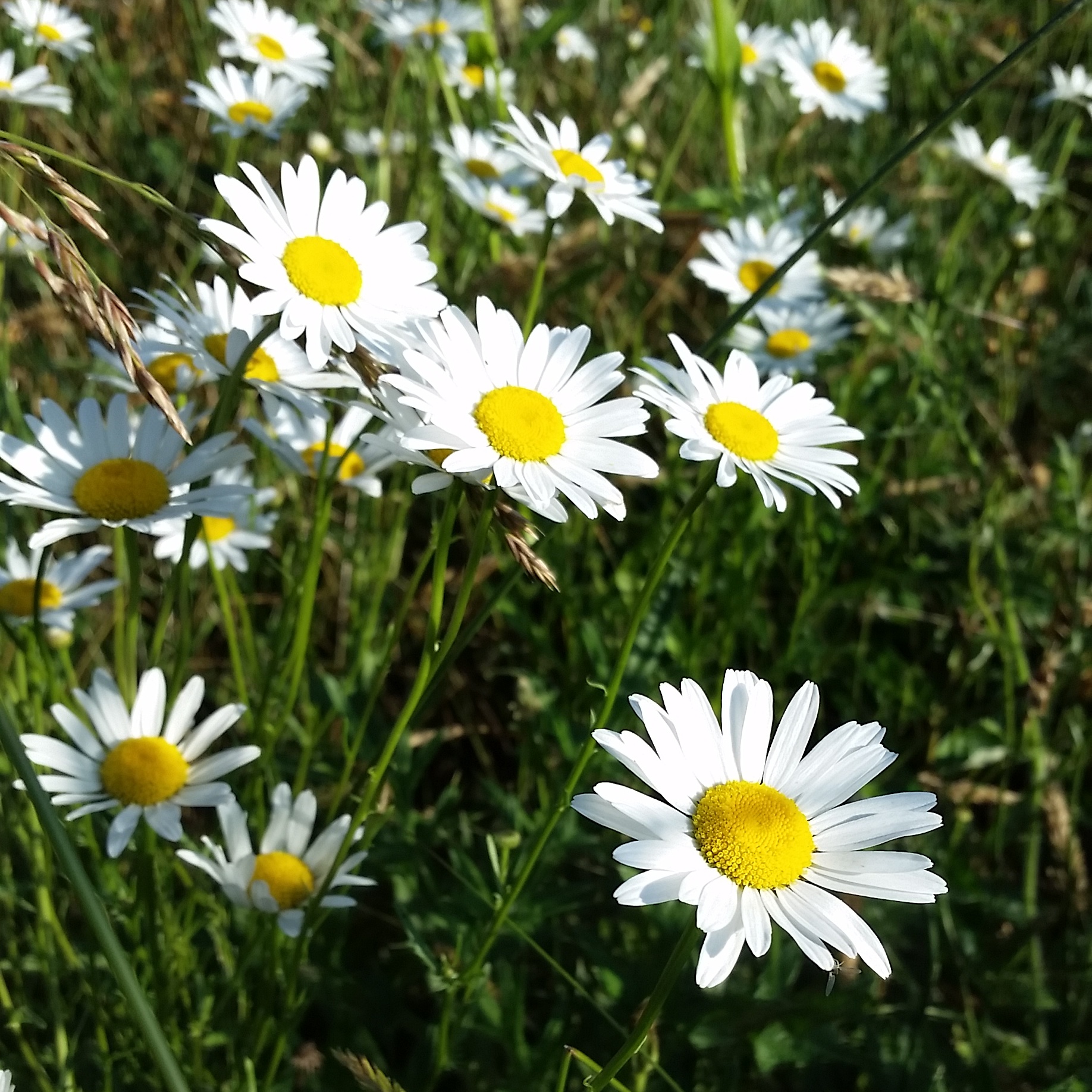Today’s plant for #WildEdibleWednesday is Leucanthemum vulgare, or the Oxeye Daisy. Most of us just call them daisies. One of the most recognizable wildflowers in the world, daisies have also been used as a medicinal plant for thousands of years. As a member of the Aster family (Asteraceae), their kin includes such medicinal luminaries as Chicory, Valerian, Liatris, Purple Aster, and Goldenrod, among many others. They’re also edible, as we’ll talk about shortly.
A perennial herb, daisies grow from a creeping taproot and produce a basal rosette of dark green, slightly hairy, spoon-shaped leaves. They send up a flower stalk up to 20” tall topped with a familiar white flower head with a yellow center. Daisies are self-fertile, meaning one plant can pollinate itself and reproduce exponentially, one of the reasons they spread so quickly. The plant is an evergreen perennial and can be found year-round if you know where to look, but they only bloom from April to the first frost. Native to most of Europe and parts of western Asia such as Turkey, daisies have naturalized to temperate areas throughout the world. They are especially at home in North and South America. Hardy and prolific, they spread quickly and are difficult to eradicate. In fact, they’re considered invasive in many U.S. states, and are banned from cultivation in Ohio, Wyoming, Washington, Montana, and Colorado. An average daisy can produce more than 4,000 seeds in a season, and those seeds can remain dormant yet viable for up to 40 years. Daisies do best in a moist, rich, nutritious soil. They are only found in bright, sunny areas – this is one plant you’ll never see in the woods. They’re the archetypal meadow wildflower, and are found most commonly in pastures, abandoned fields, on roadsides, and around abandoned home sites, as well as waste areas such as abandoned construction sites. Daisies do not have any deadly mimics, and in Georgia, the plant they get mixed up with most is Common Fleabane, which we’ll probably cover at some point this summer. The easiest way to tell them apart is the size of the flowers – daisies are much bigger. They also have wider petals.
Daisies are an edible plant, although it’s not their strongest selling point. Much of their flavor depends on the type of soil they’re grown in, but they generally have a fairly bitter, acrid flavor. They’re tolerable as a potherb if you cook them long enough. Probably the most palatable use of daisies as an edible is to pick the unopened flower buds and pickle them in brine like capers. I’ve never had them, but I’ve heard they’re delicious.
Daisies’ prime use is as a medicinal plant. Like other members of the Aster family, it’s a powerful medicinal herb with a wide range of uses. Although the leaves can be used medicinally, it’s the flower heads – fresh or dried – that you’re after. Oxeye daisy shares many properties with its cousin chamomile, and can be used almost interchangeably. A tea or infusion of the plant has the broadest range of uses – it is an antispasmodic useful for relieving the horrible racking cough associated with severe lung issues such as tuberculosis, bronchitis, or pneumonia. As a diuretic and astringent, it can help break a fever by inducing sweating and urination. It’s also soothing to the stomach, especially with honey. It can be used for calming ulcers, reducing nausea and stimulating the appetite, and treating diarrhea. Like chamomile, it’s also an anxiolytic, useful for inducing calm and helping with sleep. Externally, the tea is useful as an eye wash for conjunctivitis or irritation from dust or allergens. Also, the leaves and flowers can be used as a poultice for ulcers, bruises, and cuts. Daisies are one of the safest of wild plants to use medicinally. They have virtually no interactions with synthetic pharmaceuticals or other herbal remedies, and are even generally considered safe for pregnant or nursing women. However, some people who are allergic to other members of the Aster family such as ragweed or marigolds should try any daisy remedy in a small dose before using it. Negative reactions can range from a mild annoyance to severe enough to ruin your day.
Daises have a long association with the folk traditions of northern Europe. The Old Norse name for the flower was Baldur’s Brow, after Baldur the Beautiful, the most beloved of all the Norse gods. (Baldur was killed by the trickster god Loki as part of a prank gone horribly wrong. Viking mythology can be a real downer sometimes.) The Greeks dedicated the flower to Artemis, the goddess of femininity, as it was useful for treating women’s issues and was thought to bring fertility. Even today, it’s considered good luck in some circles for women who are trying to get pregnant to leave daisies at the ruins of temples dedicated to Artemis. In medieval Christian traditions, the daisy was associated with Mary Magdalene. Mythology and tradition aside, daisies’ invasiveness has been an issue since the beginning of agriculture. Like Bitterweed or wild onions, it can taint the milk of cows, goats, and sheep and cause an unpleasant flavor. In medieval Scotland, daisies were referred to as “gools” and each village had a unique method for controlling them – the farmer who had the most daisies in his fields at the time of the yearly census was forced to pay a special tax. You can bet that those fields were spotless.
Anyone out there tried daisies as a medicinal plant? Did we miss anything? Should we re-instate the daisy tax? Tell us in the comments!
Want to learn more about wild edible plants in a hands-on setting? Come join us for Wilderness Survival Essentials this Saturday, June 2nd! We’ll be doing a wild edible walkabout and show you how to use some of this knowledge firsthand. Register now at www.sarcraft.com/wilderness-survival-essentials!
- Alex

